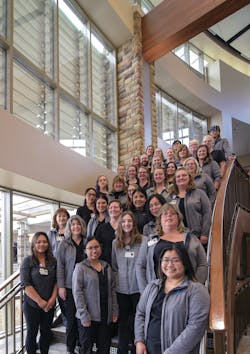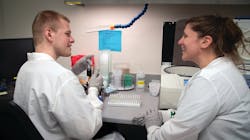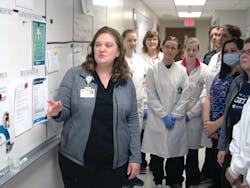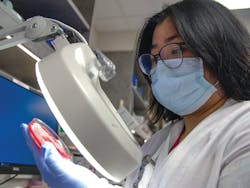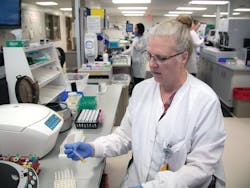Mary Greeley Medical Center Laboratory — improving culture, retention, and performance
The lab stood out for the depth and variety of initiatives its managers and staff members have undertaken to improve operational performance, employee retention, and the lab’s culture. Their achievements were measured across six categories: customer service, productivity, teamwork, education and training, laboratory inspections, and strategic outlook.
As is the case every year, judging the entries for Medical Laboratory Observer’s Lab of the Year award is a daunting job. MLO’s staff and judges read many inspiring stories about how laboratorians worked diligently to provide diagnostic services to their customers: providers and patients.
Mary Greeley Medical Center is a 220-bed regional hospital that serves people in a 13-county area in Central Iowa. So far in fiscal year 2022, the lab is experiencing a record year, averaging 48,432 tests per month, compared with 45,151 in fiscal year 2021. This includes assays processed in chemistry, hematology, coagulation, urinalysis, microbiology, immunohematology, and immunology/serology.
The growth in test volumes follows on the heels of growth in previous years. “Over the last 5 years, the lab testing volumes for the emergency department has increased over 40% and inpatient testing has increased by 20%. The COVID pandemic has been a part of that increase as well. The lab has also taken on additional reference laboratory work in microbiology,” Melanie Vorsten, MHS, MLS(ASCP), Lab Director, said.
Customer service
For providers without access to Epic, the results are faxed. If fax failures occur repeatedly, the lab’s employees follow up to ensure providers get the test results they need.
To help patients manage their health, the lab, with 38 full-time equivalents (FTEs), also offers self-pay labs tests. Patients who have signed up for the electronic patient portal have immediate access to results from those wellness labs. The screenings include cholesterol profiles, a complete lipid profile, screening tests for bone, liver, heart, kidney and thyroid function, and many others.
“It has also become a valuable tool for physicians and other healthcare providers to recommend to patients who may not have adequate health insurance, or who want to avoid the higher costs of regular laboratory testing,” Vorsten and Sarah Bower, MPA, MT(AMT), Laboratory Manager, wrote in their nomination submission.
The prices for tests range from $10 for a cholesterol test to $50 for an anti-tissue transglutaminase (tTG-IgA) test that screens for celiac disease.
Another aspect of customer service that is important at Mary Greeley is patient safety. For example, the lab has notched 100% compliance with hand hygiene rules for 24 consecutive months — the highest rate among hospital departments. One key to the success with hand hygiene has been incorporating it as a metric when managers evaluate staff members performing phlebotomy draws. The lab also tracks and then posts its hand hygiene metric on its huddle board and discusses it monthly lab meetings.
Productivity
To improve inventory management, the lab adopted a Kanban system, which allows the lab to reorder supplies only as needed, or just-in- time. To adopt the system, the lab established standard reorder points and quantities. “Productivity increased because staff spent less time trying to decide what needed to be reordered and how much to order of each item,” Vorsten and Bower wrote in their submission for Lab of the Year.
As one might expect, the lab has had to revise the Kanban system during the COVID-19 pandemic because many supplies, such as test tubes, are difficult to get, making just-in-time ordering hard to achieve. “Having the inventory system better prepared us to handle the delays and backorders. Depending on the supply item, we have either increased our order level, increased our ordering frequency, decreased our par level, or found a replacement,” Vorsten said.
Another example of increased productivity is the way the lab has managed test volume, which has grown by nearly 10,000 tests per month over the last five years. In 2017/2018, the average monthly volume of tests was 39,197, compared with 48,432 in 2021/2022. The lab has managed the increased test volume with only two new full-time equivalents. How? Lab managers have cross trained staff, retained experienced staff, and invested in new analyzers with faster TATs.
The lab also measures productivity rates by phlebotomist. “This is a tool used to reward great performers, not a punishment for underperformers,” Vorsten and Bower wrote. Productivity is calculated by hours work, expected draws completed, and actual draws completed.
The lab also measures redraw rates and blood culture contamination by phlebotomist. The current average redraw rate is 7.3%, compared with a goal of less than 5%, while the blood culture contamination rate varies from zero to 15%, compared with a goal of less than 3%. The lab posts the results by phlebotomist and department, but each phlebotomist is assigned a number to protect confidentiality. “Individual phlebotomy metrics are hugely popular with the phlebotomists, and they often ask when they will be posted,” Vorsten and Bower wrote.
The lab proactively tracks overtime, with a goal of reducing the number of extra hours that employees work. In the current fiscal year (July-June), the lab has averaged 19.02 hours per week of overtime, compared with 24.04 hours per week in the last fiscal year. “We hope to stay on track and save the lab thousands of dollars per year,” they wrote.
Teamwork
In the first step of the process, all employees were asked to describe examples of disrespectful behavior they’ve seen at work — not mentioning names, just the behavior. Based on that feedback, the leadership team developed a list of disrespectful actions. They then posted the list.
“We definitely felt as a leadership team that we could improve respect in the laboratory. In addition to being aware of our low respect scores on the (employee) engagement survey, we heard from staff during monthly rounding that there were disrespectful things going on in the lab. Some of the behaviors we heard about and focused on included people raising their voices when they were angry or stressed, too much gossip about coworkers, lack of patience with newer employees, and jumping to conclusions about someone else’s actions or intentions,” Bower explained.
Both Vorsten and Bower round with each staff member monthly, and they made a point discussing respect during each meeting for an entire year to keep the goal at the forefront of everyone’s mind. They also hired an outside consultant to work with the leadership team, and each member of the team was required to come up with a personal action item that they would work on improving.
The management team also created a laminated card that is hidden behind each employee’s badge with the phrase “Drama Ilama” written on it. The card “can be flashed in the laboratory as a light-hearted way to let someone know that they are acting in a disrespectful way. We have seen this card in use, in the breakroom and during morning huddle, to remind someone nicely to be respectful,” Vorsten and Bower wrote.
The management team also continually reminds everyone that it takes 6 months to 2 years for a new employee to become fully competent in his/her job, meaning that veteran staff members need to remain patient with their newer colleagues.
Another way the lab has fostered a sense of teamwork is through a weekly fun exercise. Called “Who am I?”, the lab’s shared decision-making council posts five random facts about an employee as well as his or her approximate years of service on the huddle board, so that everyone can see the information. Employees submit guesses on who the employee is. The names of those who guessed correctly are posted to the board, and two of those names are drawn as the winners of the contest, and they receive a candy bar. The name of the featured person also is posted as are other popular guesses.
Education and training
One position where reducing those metrics is particularly important is phlebotomy, which has a perennially high vacancy and turnover rate nationally. That is why Mary Greeley has rolled out initiatives to attract and retain employees to those positions. The minimum wage of phlebotomists was increased in 2022, and some phlebotomists saw their wages rise as much as 11%.
The lab also launched a career ladder in which phlebotomists earn a salary increase if they pass the certification exam. They can earn another raise if they are willing to cross train in specimen processing, including handling send outs to reference or specialty labs.
To help phlebotomists pass those exams, Mary Greeley purchased access to the Phlebotomy Exam Simulator from MediaLab, which includes electronic practice tests with content pertinent to the four providers of certification exams.
In 2022, the lab also converted full time and regular, part time phlebotomists to lab assistants. Before the change, the lab had four lab assistants and 16 phlebotomists, compared with 14 lab assistants and six phlebotomists after the change.
“We made this change to reward our more career-minded staff, and also to increase their feeling of connectivity to the lab (more opportunities to work closely alongside technical staff). Phlebotomy is still a main job duty, but they learn much more about the lab itself. We have already received positive feedback that what they are learning in lab has made them better phlebotomists! This has also increased our scheduling flexibility when it comes to covering open shifts,” Bower explained.
On a broader scale covering many positions, the laboratory has developed a strong relationship with the Des Moines Area Community College in Ankeny. “We currently have two students rotating through the lab, and a third student will join us after March 1. We have two phlebotomy students performing clinical rotations in February-March and have a third MLT student who will perform a phlebotomy rotation in March,” Vorsten and Bower wrote. “We believe we take a very high number of students despite our modest laboratory size.”
As a key outcome of the recruitment and retention work, the lab does not have vacant positions in medical laboratory technology (MLT)/medical laboratory science (MLS). Vorsten attributes this success to numerous factors: the lab’s close relationship with local community colleges, support for career development, and the improving culture of respect in the lab.
Lab Inspections
In 2021, the lab had its first inspection with a new accreditation organization.
Despite an unfamiliar survey process and five of seven leaders being new to their roles, the lab had only two standard level deficiencies — 493.1236(c)(1), and 493.1253 for which the lab immediately implemented corrective action.
To further help with the survey process, the lab expanded its subscription to MediaLab to include the company’s compliance module. The lab is now in the process of converting all paper documents for training and competency assessments into electronic checklists. This has already reduced the lab’s paper use significantly and has eliminated the chance that an employee will lose an almost completed paper copy. The goal is to be paperless by the end of 2022. All departments within the lab have already been converted except chemistry, which will switch over soon.
Strategic outlook
Improving patient engagement has been a key focus at the lab. For example, managers recently implemented NRC Health Real-time Feedback software, which automates the process of collecting and analyzing feedback from customer surveys. The software tracks net promoter scores, which measure customers’ willingness to recommend a product or service, based on an index ranging from -100 to +100. The NRC software measures the score in real time, with drill down capabilities for analysis.
Using the data from the surveys, lab managers noticed that patients commented on the courtesy and respect behavior of patient access representatives stationed at the lab’s front desk. With further analysis, they realized that “when the desk is very busy, patients don’t always feel acknowledged as soon as they walk in,” Bower and Vorsten wrote.
The solution turned out to be a new script, which was implemented in January 2022:
- Old response: None, or “Have a seat. I’ll be with you as soon as I can.”
- New response: “Welcome to the lab! Please make yourself comfortable, and I’ll be with you as soon as I can.”
“Since the change, we have seen a huge improvement in the courtesy and respect question. The score for this category improved from 71.4 to 85.7. The lab’s overall Net Promoter Score improved from 79.8 to 89.9,” Vorsten said.
Taken together, Mary Greeley Medical Center Laboratory’s achievements in strategy, productivity, customer service, teamwork, inspections, and training positioned it well to exceed its improvement goals in 2021, despite the pandemic, turnover in phlebotomy, increasing test volumes and new lab leadership. Those achievements also position the lab to succeed in the future — no matter what challenges come its way.
Linda WIlson
Senior Editor


